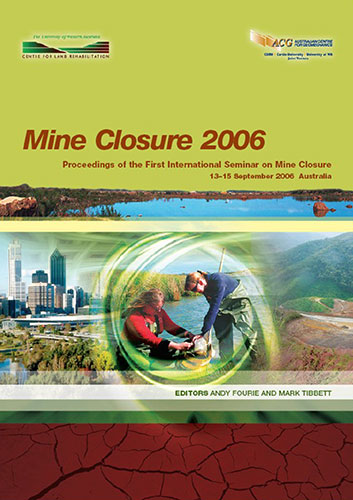Legislating for Quicker and Better Rehabilitation

|
Authors: Wilson, IH Paper is not available for download Contact Us |
DOI https://doi.org/10.36487/ACG_repo/605_67
Cite As:
Wilson, IH 2006, 'Legislating for Quicker and Better Rehabilitation', in AB Fourie & M Tibbett (eds), Mine Closure 2006: Proceedings of the First International Seminar on Mine Closure, Australian Centre for Geomechanics, Perth, pp. 761-771, https://doi.org/10.36487/ACG_repo/605_67
Abstract:
Queensland has developed a comprehensive and effective set of legislation for mining. Rehabilitation is a relatively late addition to the legislation and although it first appeared about 60 years ago, few mines had legislative obligations to undertake rehabilitation until the 1980s and it did not become mandatory until 1990. This paper examines the reasons rehabilitation requirements have become significant and why they are still changing. It also shows how this has been reflected in the legislation and comments on available measures of the area of rehabilitation and the lack of information on the quality of rehabilitation. Experiments with self-regulation in the 1990s do not appear to have fostered a desire to undertake rehabilitation. Recent legislative changes have provided opportunities for getting better rehabilitation and completing it as early as possible. The constraining factors are cost and the levels of technical knowledge about rehabilitation in both the mining companies and the regulators. The current effort is directed towards technical and procedural guidelines to provide greater certainty in decision-making.
References:
ABS (2001) Queensland Year Book. Australian Bureau of Statistics, Brisbane.
ANZMEC and MCA (2000) Strategic Framework for Mine Closure. Australian and New Zealand Minerals and Energy
Council and Minerals Council of Australia, Canberra.
www.minerals.org.au/__data/assets/pdf_file/7499/MineClosureFramework.pdf
CFMEU (2000) Union calls on ACCC to prosecute coal price fixers. The Guardian, August 2, 2000.
COA (1992) National Strategy for Ecologically Sustainable Development. Australian Government Publishing Service,
Canberra.
COAG (1992) InterGovernmental Agreement on the Environment. Council of Australian Governments, Canberra.
CSIRO (1998) A Guidebook to Environmental Indicators. CSIRO Australia, Canberra.
Department of Mines (1976) Queensland Mining Guide (1976 Edition). Department of Mines, Brisbane.
DME (1992) Environmental Management for Mining in Queensland. Department of Mines and Energy, Brisbane.
EPA (2003) Financial Assurance for Mining Activities (Guideline 17). Environmental Protection Agency, Brisbane.
www.epa.qld.gov.au.
Legislating for Quicker and Better Rehabilitation I.H. Wilson
770 Mine Closure 2006, Perth, Australia
EPA (2006) Rehabilitation Requirements for Mining Projects (Guideline 18). Environmental Protection Agency,
Brisbane. www.epa.qld.gov.au.
ICMM (2005) Financial Assurance for Mine Closure and Reclamation. International Council on Mining and Matals,
London. www.icmm.com.
MCA (2004) Enduring Value. Minerals Council of Australia, Canberra.
Palaszczuk, H. (2006) Increased funding for mineral and petroleum services. Media Release, June 6, 2006, Minister for
Natural Resources, Mines and Water, Brisbane.
Plunkett, M. and Sheehy, P. (1973) The Water Report. Legalised Pollution. The Public Interest Research Group,
University of Queensland Press, St Lucia, pp. 39-81.
Queensland Government (1980) Queensland Resources Atlas. Premiers Department, Brisbane.
Welsh, D., Hinz, R., Garlipp, D. and Gillespie, N. (1994) Coal Mines on Target with Environmental Planning.
Queensland Government Mining Journal, February 1994, pp. 19-22.
Success Criteria
Mine Closure 2006, Perth, Australia 771
© Copyright 2025, Australian Centre for Geomechanics (ACG), The University of Western Australia. All rights reserved.
View copyright/legal information
Please direct any queries or error reports to repository-acg@uwa.edu.au
View copyright/legal information
Please direct any queries or error reports to repository-acg@uwa.edu.au